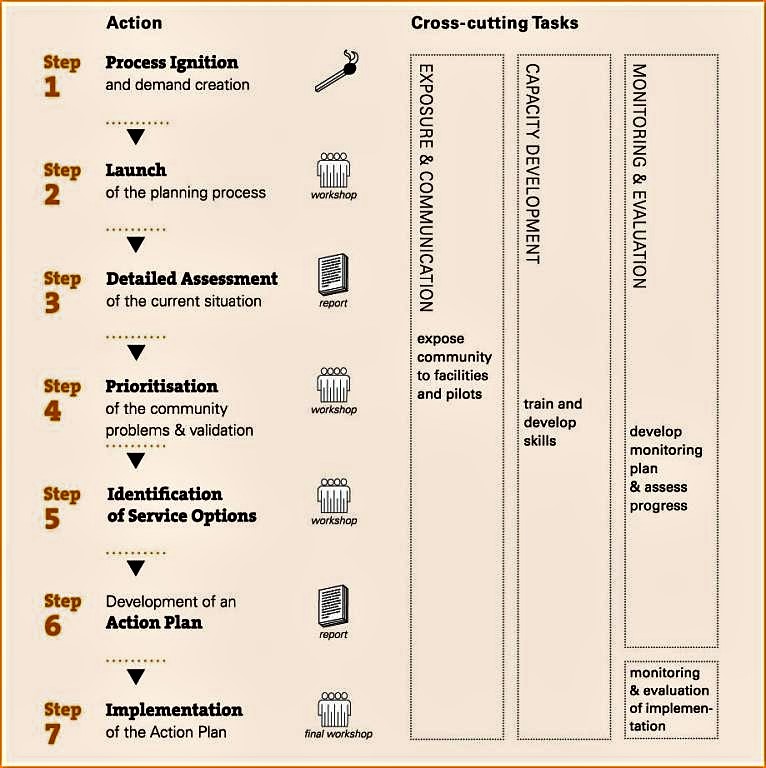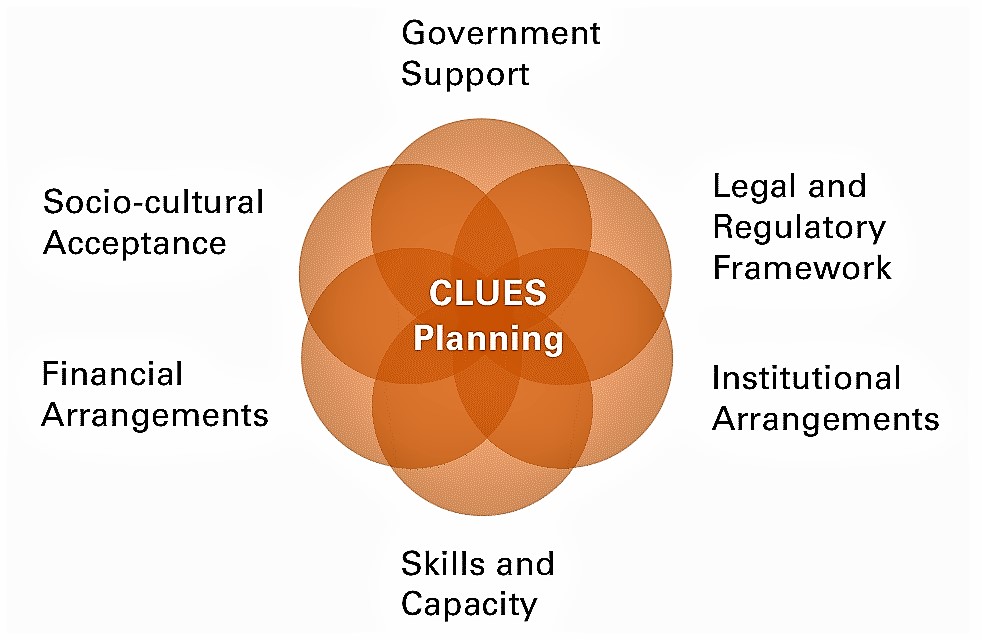Executive Summary
The Community-Led Urban Environmental Sanitation (CLUES) approach presents comprehensive guidelines for the planning and implementation of environmental sanitation infrastructure and services in disenfranchised urban and peri-urban communities. The planning approach builds on a framework, which balances the needs of people with those of the environment to support human dignity and a healthy life. CLUES is a multi-sector and multi-actor approach for the planning and implementation of water supply, sanitation, solid waste management and storm drainage. It emphasises the participation of all stakeholders from an early stage in the planning process.
Introduction

CLUES is a further development of the Household-Centred Environmental Sanitation (HCES) planning approach (EAWAG 2005), which is based on the Bellagio principles for sustainable sanitation (EAWAG/SANDEC & WSSCC 2000). HCES was conceived by the Environmental Sanitation Working Group of the Water Supply and Sanitation Collaborative Council (WSSCC). Intensive piloting and evaluation of the HCES approach took place between 2006 and 2010 in Africa, Asia and Latin America, in seven different urban and peri-urban sites. The experiences and lessons learned from these pilot projects were used to develop a revised and simplified set of planning guidelines (LUETHI et al. 2011). The name change from HCES to CLUES highlights the importance of broad community involvement (beyond the household level) in the planning and decision-making process.
In a CLUES process, the most sustainable solutions are identified through the involvement and mobilisation of all stakeholders, particularly the targeted community, and by taking into account the complex realities, priorities and available resources on the ground. CLUES planning includes the development of a timed and output-based action plan which is implementable by the community, the local authority and the private sector, and elaborates management strategies for operation and maintenance of the solutions put in place.
The CLUES approach includes three distinct elements: 7 planning steps, 3 cross-cutting tasks relevant throughout the entire planning process, and the enabling environment which is required for sustainable interventions.
The 7 Planning Steps
Step 1: Process Ignition and Demand Creation
The planning process begins with ignition and promotional activities. This step aims at sensitising the community to environmental sanitation and hygiene issues and to create momentum and a solid platform for community participation. After a participative community mapping exercise and the discussion of key concerns with the residents in a first community meeting, an agreement on action is formulated and a community task force is formed by previously identified community champions.
Step 2: Launch of the Planning Process
In step 2 all key stakeholders formally come together to develop a common understanding of the environmental sanitation problems in the intervention area and agree on the process of how to address them. The launching workshop must be inclusive, well-structured and attract public attention. In step 2 stakeholders generate a protocol agreement, an agreement on the project boundaries and an agreement on the overall planning methodology and process.
Step 3: Detailed Assessment of the Current Situation
In step 3 stakeholders compile information about the physical and socio-economic environment of the intervention area. This step is important because it provides necessary background information for all future planning steps. Outputs include a refined stakeholder analysis, baseline data, and a thorough assessment of the enabling environment and current levels of service provision. The main outcome of step 3 is a detailed status assessment report for the intervention area.
Step 4: Prioritisation of the Community Problems and Validation
In step 4 stakeholders deliberate the findings and implications of the assessment report, and identify and prioritise the leading general and environmental sanitation problems in the community. The main outcomes of step 4 are the validated assessment report and an agreed-upon list of priority problems in the community.
Step 5: Identification of Service Options
In step 5 the planning team, in consultation with environmental sanitation experts and key stakeholders, uses an informed choice approach to identify one or two environmental sanitation system options that are feasible for the intervention area and can be studied in greater detail. The community and the local authorities reach agreement based on an understanding of the management and financial implications of the selected systems.
Step 6: Development of an Action Plan
In step 6 stakeholders develop local area action plans for the implementation of the environmental sanitation options selected in step 5. The action plans must be implementable by the community; the local authorities and the private sector (see also public private partnerships). The main output of step 6 is a funded action plan that follows time sensitive, output-based targets. Every action plan must contain an operation and maintenance management plan to ensure the correct functioning of the sanitation system.
Step 7: Implementation of the Action Plan
As the goal of step 7 is to implement the CLUES action plan developed in step 6, this last step strictly speaking is not part of the planning process. Stakeholders translate the action plan into work packages, which ultimately become contracts for implementing the service improvements. The final stage of step 7 is the implementation of the operation and maintenance management plan.
Who should be involved in the launch of the planning process?
The official launch of the process should be held after the community meeting of step 1 in the form of a multi-stakeholder workshop. An expert facilitator should moderate the workshop. It should be attended by the various stakeholders identified during the kick-off events and should include the process leader, municipal health officers, municipal and district authorities, utility representatives, NGOs, university lecturers and students and representatives from the community, including the project coordination committee.
Cross-cutting Tasks
There are 3 cross-cutting tasks which are relevant throughout the entire planning process:
- Awareness raising and communication are key to creating demand and raising people’s abilities to make informed choices about the most appropriate systems and technologies.
- Capacity development aims at strengthening process management and collaborative planning skills as well as engineering, construction, operation and maintenance skills.
- Process monitoring and evaluation (see also: participatory monitoring and evaluation) allows the identification and correction of mistakes or imbalances and the changing of shape and direction of the project before it is too late.
The Six Elements of the Enabling Environment

In order for a CLUES process to be successful, it has to take place in a so-called enabling environment. An enabling environment can be seen as the set of interrelated conditions that impact on the potential to bring about sustained and effective change (WORLD BANK 2003). This includes political, legal, institutional, financial and economic, educational, technical and social conditions, which encourage and support certain activities. An enabling environment is important for the success of any development investment; without it, the resources committed to bringing about change will be ineffective. The six elements that define an enabling environment (see figure below) need to be nurtured and pro-actively fostered to provide favourable conditions for planning in challenging urban environments. CLUES includes a framework for the identification and assessment of critical elements and explains how they can be addressed and developed to support an enabling environment and facilitate the progress.
Most of the critical elements to support an enabling environment should be identified or become evident during the planning process. Ideally, these elements should be identified, at least in broad terms, prior to starting the planning and consultative process (step 2 in the 7-step programme), so that the entire process does not start off with unrealistic expectations or misconceptions.
Subscribe here to the new Sanitation and Water Entrepreneurship Pact (SWEP) newsletter. SWEP is a network of organizations joining hands to help entrepreneurs design and develop lasting water and sanitation businesses.
The CLUES approach is geared towards the community level and is meant to complement citywide infrastructure planning approaches, such as Sanitation 21 Framework or City Sanitation Plans. The geographical focus is on informal and unplanned urban and peri-urban settlements in Africa, Asia and Latin America, where service improvements are challenging.
As stated above, an enabling environment and how it is understood is a key determinant for successful and effective project interventions. The effectiveness and success of a CLUES process heavily depends on favourable local conditions. For example, the community should be relatively homogeneous without insurmountable internal frictions. Transient communities without social cohesion should be avoided.
Hence, the applicability of CLUES has to be evaluated by reviewing the existing local situation and deciding what needs to be addressed in order to allow the programme to succeed, and by working towards securing these changes.
In pilot scale projects conducted by Eawag (LUETHI et al. 2009), the criteria for selecting the sites included proven interest from population and authorities; specific, easily definable neighbourhoods within a larger city; proven community self-organisation; proven institutional support within the region; opportunity for follow-up investment and implementation.
Household-Centred Environmental Sanitation, Implementing the Bellagio Principles in Urban Environmental Sanitation – Provisional Guideline for Decision Makers
This guideline for decision-makers has been developed to provide first guidance on how to implement the Bellagio Principles by applying the HCES approach. Assistance is given to those willing to include and test this new approach in their urban environmental sanitation service programmes. Since practical experience with the HCES approach is lacking, this guideline is neither comprehensive nor final, but will have to be developed further on the basis of extensive field experience. Available in English, French and Spanish.
EAWAG (2005): Household-Centred Environmental Sanitation, Implementing the Bellagio Principles in Urban Environmental Sanitation – Provisional Guideline for Decision Makers. Geneva, Switzerland: Swiss Federal Institute of Aquatic Science and Technology URL [Accessed: 17.06.2019]Summary Report of Bellagio Expert Consultation on Environmental Sanitation in the 21st Century
This report summarises the Bellagio principles, which can be considered a basis for sustainable sanitation approaches.
EAWAG ; SANDEC ; WSSCC (2000): Summary Report of Bellagio Expert Consultation on Environmental Sanitation in the 21st Century. Duebendorf & Geneva: Swiss Federal Institute for Aquatic Science and Technology EAWAG & Water Supply and Sanitation Collaborative Council URL [Accessed: 18.06.2019]People’s Choice First, A 4-Country Comparative Validation of the HCES Planning Approach for Environmental Sanitation
From 2006 until the end of 2008, the HCES guidelines, and the concept of a participatory top-down/bottom-up planning approach, were tested in seven different urban and peri-urban sites across Africa, Asia and Latin America. Case studies from four of the seven sites are presented and analysed in this publication.
LUETHI, C. MOREL, A. KOHLER, P. TILLEY, E. (2009): People’s Choice First, A 4-Country Comparative Validation of the HCES Planning Approach for Environmental Sanitation. (= NCCR North-South Dialogue, no. 22 ). Bern: NCCR North-South URL [Accessed: 18.06.2019]Integrate at the Top, Involve at the Bottom – The Household-Centred Approach to Environmental Sanitation. Paper presented at the IRC Symposium: Sanitation for the Urban Poor Partnerships and Governance
This paper presents initial experience with implementation of the Household-Centred Environmental Sanitation (HCES) approach, jointly developed by the WSSCC and EAWAG-SANDEC. The presentation explores the theoretical foundations, the problems it seeks to address and practical experience with implementing the novel planning approach, presenting two case studies, one each from Tanzania and Laos.
LUETHI, C. MOREL, A. TILLEY, E. (2008): Integrate at the Top, Involve at the Bottom – The Household-Centred Approach to Environmental Sanitation. Paper presented at the IRC Symposium: Sanitation for the Urban Poor Partnerships and Governance. URL [Accessed: 18.06.2019]Community-Led Urban Environmental Sanitation Planning (CLUES)
CLUES presents a complete set of guidelines for sanitation planning in low-income urban areas. It is the most up-to-date planning framework for facilitating the delivery of environmental sanitation services for urban and peri-urban communities. CLUES features seven easy-to-follow steps, which are intended to be undertaken in sequential order. Step 5 of the planning approach relies on the Compendium, applying the systems approach to select the most appropriate technological option(s) for a given urban context. The document also provides guidance on how to foster an enabling environment for sanitation planning in urban settings. Published in 2011, 100 pages, with a memory key.
LUETHI, C. MOREL, A. TILLEY, E. ULRICH, L. (2011): Community-Led Urban Environmental Sanitation Planning (CLUES). Dubendorf: Swiss Federal Institute of Aquatic Science and Technology (Eawag) URL [Accessed: 18.06.2019]Enabling Environments for Civic Engagement in PRSP Countries. Social Development Notes
Household-Centred Environmental Sanitation, Implementing the Bellagio Principles in Urban Environmental Sanitation – Provisional Guideline for Decision Makers
This guideline for decision-makers has been developed to provide first guidance on how to implement the Bellagio Principles by applying the HCES approach. Assistance is given to those willing to include and test this new approach in their urban environmental sanitation service programmes. Since practical experience with the HCES approach is lacking, this guideline is neither comprehensive nor final, but will have to be developed further on the basis of extensive field experience. Available in English, French and Spanish.
EAWAG (2005): Household-Centred Environmental Sanitation, Implementing the Bellagio Principles in Urban Environmental Sanitation – Provisional Guideline for Decision Makers. Geneva, Switzerland: Swiss Federal Institute of Aquatic Science and Technology URL [Accessed: 17.06.2019]Integrate at the Top, Involve at the Bottom – The Household-Centred Approach to Environmental Sanitation. Paper presented at the IRC Symposium: Sanitation for the Urban Poor Partnerships and Governance
This paper presents initial experience with implementation of the Household-Centred Environmental Sanitation (HCES) approach, jointly developed by the WSSCC and EAWAG-SANDEC. The presentation explores the theoretical foundations, the problems it seeks to address and practical experience with implementing the novel planning approach, presenting two case studies, one each from Tanzania and Laos.
LUETHI, C. MOREL, A. TILLEY, E. (2008): Integrate at the Top, Involve at the Bottom – The Household-Centred Approach to Environmental Sanitation. Paper presented at the IRC Symposium: Sanitation for the Urban Poor Partnerships and Governance. URL [Accessed: 18.06.2019]Community-Led Urban Environmental Sanitation Planning (CLUES)
CLUES presents a complete set of guidelines for sanitation planning in low-income urban areas. It is the most up-to-date planning framework for facilitating the delivery of environmental sanitation services for urban and peri-urban communities. CLUES features seven easy-to-follow steps, which are intended to be undertaken in sequential order. Step 5 of the planning approach relies on the Compendium, applying the systems approach to select the most appropriate technological option(s) for a given urban context. The document also provides guidance on how to foster an enabling environment for sanitation planning in urban settings. Published in 2011, 100 pages, with a memory key.
LUETHI, C. MOREL, A. TILLEY, E. ULRICH, L. (2011): Community-Led Urban Environmental Sanitation Planning (CLUES). Dubendorf: Swiss Federal Institute of Aquatic Science and Technology (Eawag) URL [Accessed: 18.06.2019]Community-Led Urban Environmental Sanitation Planning (CLUES). Executive Summary
This two-page document provides an overview of the CLUES approach with its three distinct elements: 7 planning steps, 3 cross-cutting tasks relevant throughout the entire planning process, and the enabling environment which is required for sustainable interventions.
LUETHI, C. MOREL, A. TILLEY, E. ULRICH, L. (2011): Community-Led Urban Environmental Sanitation Planning (CLUES). Executive Summary. Dubendorf: Swiss Federal Institute of Aquatic Science and Technology (Eawag). [Accessed: 12.11.2011] PDFCommunity-Driven Sanitation Improvement in Deprived Urban Neighbourhoods
There is an international consensus that urban sanitary conditions are in great need of improvement, but sharp disagreement over how this improvement should be pursued. Both market-driven and state-led efforts to improve sanitation in deprived communities tend to be severely compromised, as there is a lack of effective market demand (due to collective action problems) and severe barriers to the centralized provision of low-cost sanitation facilities. In principle, community-driven initiatives have a number of advantages. This report investigates these challenges and opportunities.
MCGRANAHAN, G. (2013): Community-Driven Sanitation Improvement in Deprived Urban Neighbourhoods. Research Report. London, Bangladesh: London School of Hygiene and Tropical Medicine (LSHTM), International Center for Diarrhoeal Disease Research (ICDDR), International Institute for Environment and Development (IIED), WaterAid, Sanitation and Hygiene Applied Research for Equity (SHARE) URL [Accessed: 17.06.2019]People’s Choice First, A 4-Country Comparative Validation of the HCES Planning Approach for Environmental Sanitation
From 2006 until the end of 2008, the HCES guidelines, and the concept of a participatory top-down/bottom-up planning approach, were tested in seven different urban and peri-urban sites across Africa, Asia and Latin America. Case studies from four of the seven sites are presented and analysed in this publication.
LUETHI, C. MOREL, A. KOHLER, P. TILLEY, E. (2009): People’s Choice First, A 4-Country Comparative Validation of the HCES Planning Approach for Environmental Sanitation. (= NCCR North-South Dialogue, no. 22 ). Bern: NCCR North-South URL [Accessed: 18.06.2019]Environmental Sanitation Improvement Plan for Nala Development
This report presents the results of the Household-Centered Environmental Sanitation approach (HCES), validated in Nala, Nepal. The experience and lessons learned from this pilot project were used to develop the revised and simplified set of planning guidelines for CLUES.
CIUD (2010): Environmental Sanitation Improvement Plan for Nala Development . Kathmandu: Centre for Integrated Urban Development (CIUD)CLUES planning: introduction to the approach and case study from Nepal. Conference presentation
This presentation summarises the CLUES planning process in Nala, a peri-urban settlement near Kathmandu, Nepal. In Nala, there has been a strong demand from community to improve sanitation conditions. The document provides conclusions about the strengths and weaknesses of the CLUES approach, based on the case study in Nala.
SHERPA, M. (2011): CLUES planning: introduction to the approach and case study from Nepal. Conference presentation. Mumbai: WSSCC Global Forum on Sanitation and HygienePlanning Tools
This Sustainable Sanitation Practice (SSP) issue contains the following contributions: 1. Better Design Planning Tools, 2. Tackling Complex Urban Sanitation Problems, 3. The SSWM Toolbox, 4. Comparing Economic Costs of Sanitation
MUELLEGGER, E. ; LANGEGRABER, G. ; LECHNER, M. (2011): Planning Tools. (= Sustainable Sanitation Practice , 7 ). Vienna: Ecosan Club URL [Accessed: 01.07.2013]Guidelines for Community-Led Urban Environmental Sanitation Planning (CLUES)
This website of SANDEC, the Department of Water and Sanitation in developing Countries at the Swiss Federal Institute of Aquatic Science and Technology (EAWAG) provides more information on the CLUES approach. On this site you find a more interactive version of the guidelines, tool updates, interesting links as well as news on CLUES projects from all over the world.


